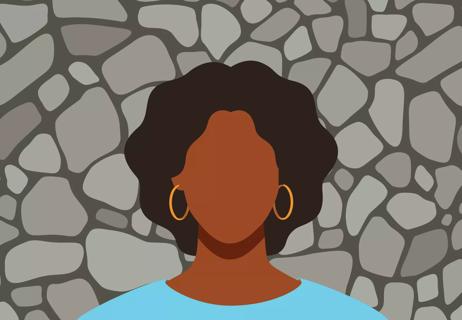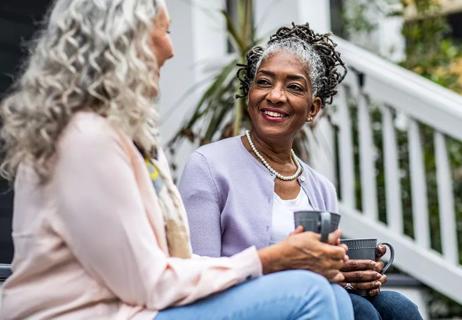Communication is key, but so is kindness

Some people say that when you’re in a healthy relationship, everything just comes easy. Others will say that’s not exactly true — the best long-term relationships require a lot of hard work, dedication and determination.
Advertisement
Cleveland Clinic is a non-profit academic medical center. Advertising on our site helps support our mission. We do not endorse non-Cleveland Clinic products or services. Policy
While we can certainly all agree that no one relationship is perfect and that every relationship comes with its own set of unique challenges, it’s perhaps true that a healthy relationship takes all of these things combined with people who love, respect and support each other.
But how do you know if you can really trust that it’s true? When can you let your guard down and feel assured that your relationship is, in fact, healthy and headed for long-term territory? The psychology of love may be a bit complex, but it doesn’t have to be a brain-buster.
Registered psychotherapist Natacha Duke, MA, RP, has some tell-tale signs that you’re in it for the long haul, as well as some checks and balances you can do along the way to reassure this relationship is healthy and right for you.
A healthy relationship at its core is centered around:
Having similar values and goals is perhaps the turning point for most relationships, as they fundamentally fuel almost everything else that you do.
Everyone’s needs ebb and flow, based on personal experiences. For example, it might be important for someone to have a partner who’s interested in volunteering and community service, whereas in other relationships that might not be as crucial. For the person who comes from a tight-knit family and prioritizes family gatherings around the holidays, they might be faced with some difficulty dating someone who disregards the importance of family.
Advertisement
“There are so many things that can go into a healthy relationship and some things are so personal to each of us,” notes Duke. “The point is that there’s a reasonable amount of reliability and that you both feel as though the other person is going to prioritize you and be true to their word every step of the way.”
The unfortunate issue is that everyone doesn’t always know they’re in a healthy relationship. That’s especially true if you’ve been caught up in problematic relationships in the past and if you’ve had a hard time recognizing red flags in one.
“Relationships can sometimes feel familiar, comfortable or better than other relationships you’ve had but that doesn’t mean it’s healthy,” states Duke. “If we have a history of problematic relationships or we don’t have a secure attachment formed in childhood, we can end up moving toward what’s familiar even though it’s not healthy. And that’s where you have to be careful.”
That requires a certain level of self-reflection before starting a new relationship. But even when you’ve been dating someone for a while, the healthiest relationships keep the door open for self-reflection, build off the mistakes you’ve each learned in the past and allow everyone to confront conflict together in a safe, constructive and helpful way.
“There are going to be times in every relationship that are going to be hard, but I think it’s how you deal with it that matters,” encourages Duke. “People in a healthy relationship should put each other at ease, have a willingness to work and grow together and be respectful of each other.”
It’s easy to get swept up off your feet in all the twists and turns a new relationship has to offer, but once you begin building a solid foundation, these key signs reinforce a long-lasting healthy relationship:
Setting up healthy boundaries isn’t always about drawing a line in the sand when things go south. Boundaries are good to put into place when we know crossing them would violate our mental, emotional and physical health or values. But they’re also good for establishing a level of respect for each other and for understanding the things you both feel are important.
“In a healthy relationship, you’re making space for each other, you’re making space for each other’s emotions, and making space to nurture and cultivate other aspects of each other’s lives,” Duke explains. “It’s also about being aware of your own personal boundaries.”
So, if your partner isn’t too keen on one of your friends, but that relationship is still important to you, it’s a good sign if your partner doesn’t try to prevent you from seeing them or isolate you from your friend group.
Advertisement
Healthy boundaries also exist in an intimate or sexual space, too. No one should ever feel pressured or ashamed when interacting with each other inside that space.
“If you’ve worked through your relationship baggage and you’ve worked through your blind spots, hopefully, you come to a new relationship feeling more neutral about trusting someone else,” says Duke. “From there, you either come to trust this new person more and more over time, or you come to not trust them over time.”
And trust extends from the seemingly smallest things, like trusting someone with your emotions or allowing yourself to be vulnerable around them, as well as with making some big life decisions — like where to live and what you want your future family to look like — that will (hopefully) take you both into consideration and benefit all involved.
Long after the honeymoon phase has ended, a sign of a healthy relationship is knowing that you can rely on your partner without second guessing whether or not you can trust them. And there’s no real replacement for time when it comes to trust.
“It’s kind of easy to have a relationship during the good times, but what really makes a relationship or bonds you as a couple is going through hard times together,” Duke says.
Advertisement
That means you want to find ways to express how you’re feeling, practice active listening when your partner is doing the same and work together to find solutions — even when you’re arguing.
“You don’t always have to see each other eye-to-eye, but you can always be both good and kind to each other and can always seek to understand the other person,” emphasizes Duke. “That’s what’s going to differentiate this relationship from another relationship that may not have a healthy longevity.”
In most cases, when there’s a conflict, you want to feel heard and understood and you want to come out of it feeling like the solution is a win-win for both of you, so there isn’t any lingering resentment from either side. But, going back to trust, it’s also good to disagree sometimes.
“If you can get through difficulties together, that builds trust, and the more you build that trust together, the stronger you become,” notes Duke.
So, even when you disagree about a problem or a solution, or even something mundane that happens during your day-to-day, finding a way to compromise is key.
“If someone hasn’t had a positive or secure attachment in their childhood, they can end up holding grudges and find it difficult to forgive people,” explains Duke. “But there’s no such thing as a perfect relationship, and forgiveness is often a sign of love.”
Advertisement
If you have difficulty letting go or moving beyond problems that surface, or if you have a hard time with forgiveness, cognitive behavioral therapy can help identify some of the triggers that reinforce that behavior, as well as provide coping mechanisms you can try when conflict inevitably happens again down the line.
Perhaps one of the most common complaints in relationships is that someone is making more effort than the other. No one likes a one-sided relationship — but how do you find a way to balance everything equally, or at least be comfortable with what everyone is giving toward the relationship?
“You can always do some reality testing,” suggests Duke. “The best way to do that is to ask yourself, ‘Is this real? Is this true? Is it accurate that I’m holding more weight than the other person?’ And another way to test it is to bring your concerns to the person and talk about it and see if they’re going to put in more effort if you need them to or if nothing’s going to change.”
However it shakes out, a healthy relationship will likely ebb and flow, with one partner making up the slack for when another person can’t, and vice-versa.
This certainly feels like a no-brainer, but we probably don’t think of this one as often as we should. What exactly does kindness look like in a healthy relationship?
“Kindness looks like feeling as though you’re safe, supported and a priority to the other person,” Duke illustrates. “It looks like apologizing when you’ve made a mistake. It means active listening, as much as possible, to your partner.”
That means at every turn, it’s OK to check in with yourself and curb your anger or expectations in order to make space for a level of kindness that’s rooted in mutual respect. It’s not always going to work or even be a perfect solution, but having the intention to always be kind as much as possible is a solid foundation for a healthy relationship.
“If you’ve known someone for a long time, you’re not going to be perfectly kind all the time, but I think there should be a certain amount of mutual respect and empathy toward each other, even when you’re not having a good day,” Duke continues.
Maybe your weekly after-work routine is composed of playing video games with each other or watching your favorite shows. For the most part, your mutual interests are aligned. But when your partner suddenly plans to run a marathon, which means they’ll have to carve out time for training, you’re still supportive of those goals and you flex your time and availability when needed.
The importance of doing things together and allowing and supporting each other’s personal growth in a healthy relationship is two-fold: It allows you both to share the things you love with each other, and it gives you the space to be supportive even when something doesn’t fully align with your own individual interests.
“There are some things that are more important to some people than others,” Duke recognizes. “For some people, it’s really important for their person to be a part of their friend group. For others, that’s not very important. So, you have to find ways to compromise with each other without feeling like it’s a struggle or a sacrifice.”
You’re not going out and buying big household items without consulting your partner first, and you make the time for your partner’s input. Sure, this isn’t always a perfect scenario, and sometimes, we can get a bit ahead of ourselves, but like with kindness, you should view the person you’re in a relationship with as your partner — a true team member you can call in for anything good, bad or ugly.
Speaking of the ugly, you don’t want to avoid having difficult conversations in a healthy relationship. You want to confront issues head-on (and be kind when doing so) and find ways to express your feelings even when you know you have to talk about challenges that might put on the heat and increase the pressure.
“It’s always good to be intentional and self-reflective and to be thoughtful in a conflict,” advises Duke. “We don’t enter relationships, nor do we have to, having everything figured out because we will never have everything figured out. There does need to be a certain level of self-understanding for our relationships to be able to be healthy though, and we all have hot-button issues.”
Expressing those issues in a constructive way is paramount to making sure boundaries for everyone are put in place and respected. And finding ways to mediate conflict together can be helpful in the long run.
“To be able to look back on previous relationships and friendships and reflect on what are the things that make you mad, what tends to hurt your feelings and what causes conflicts is really important,” says Duke.
“We can bring those things to the next relationship, and when something comes up, we can really own it and say, ‘This is an issue for me, let me help you understand why this is an issue for me,’ and work through it together.”
And this doesn’t just apply to conflict management — knowing who you are as an individual and chasing after your own personal goals and dreams are just as important because this allows you to embrace a self-love perspective that will only further enhance your relationship.
Let goblin mode commence: You don’t always have to be perfect in front of your partner, and that’s especially true in the healthiest of relationships. Part of this goes back to being kind to one another, but in a different way.
Kindness can extend to allowing you and your partner to let go of responsibility sometimes in exchange for personal development. You’ll find that when you let your guard down with one another, the healthiest of relationships allow for a different level of intimacy and understanding.
“In order to enjoy a healthy relationship, we need to be prepared to be vulnerable with one another,” says Duke. “Sometimes, this might mean sharing parts of ourselves that we feel insecure about in order to see if this relationship could have the makings of something special.”
Self-doubt is a powerful opponent, but there are some checks and balances you can put into place to reassure you that you’re in a good place in your relationship or to define exactly what needs improving.
“One thing you can continue to check in with yourself about over time is whether or not your trust towards this person is growing,” says Duke. “Is there something you’re not getting that you need? Is there something you’re not doing that your partner needs?”
Having the occasional, even informal, discussion about how each of you is feeling in a relationship is a great tool to carry things forward, even if it’s early in a relationship. By doing so, you can make sure you’re both on the same page and working toward the same goals.
“If it’s on your mind, even if it’s something good, don’t be afraid to bring it up,” reinforces Duke. “We tend to not communicate as much as we need, and you can rarely over-communicate when it comes to how you’re feeling. Checking in with yourself and the other person to make sure you continue to have similar goals and similar values is as equally important as anything else.”
Learn more about our editorial process.
Advertisement

This manipulative tactic sucks people back into destructive relationships

This toxic approach to conflict is unintentional or intentional and verbal or nonverbal

Communication and honesty are key to all relationships, even in ‘gray zone’ situationships

Whether parasocial relationships are rewarding or dangerous depends on your mental health

To reignite the spark, work on strengthening your communication and reestablishing trust

Intense longing and extreme physical attraction can happen within seconds of seeing someone

Healthy boundaries are important to put in place for friends, family and co-workers

It’s not hard when you appreciate yourself and ignore the expectations of others

Type 2 diabetes isn’t inevitable with these dietary changes

Applying a hot or cold compress can help with pain